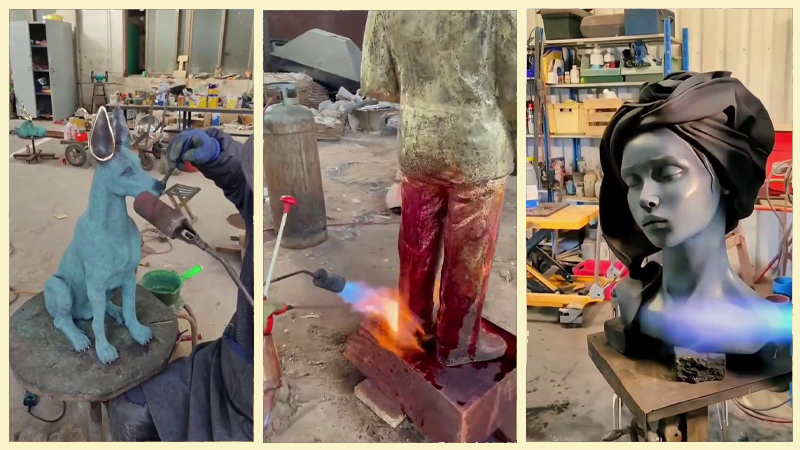The coloring of bronze sculptures is a crucial step in the creative process. It’s when the artist can truly bring their vision to life and add the finishing touches to their creation. The process of coloring bronze sculptures requires a certain level of expertise and skill as it’s not just about painting the sculpture but understanding the properties of the metal itself.
Firstly, the surface of the bronze sculpture needs to be prepared for painting. This involves cleaning any impurities or imperfections on the surface and making sure it’s free from any grease or oil. The surface is then treated with a primer coat, which acts as a base for the paint to adhere to.
Next, the artist selects their colors. This is a crucial step as the choice of colors can greatly affect the overall look and feel of the sculpture. The artist may use traditional oil-based paints or more modern water-based paints, depending on their preference and the effect they’re aiming for.
Once the colors are selected, the artist begins to apply them to the sculpture. This can be a time-consuming process as it requires great attention to detail. The artist must be able to create realistic shading and shadows,copy the texture of the material being depicted, and ensure that the paint doesn’t run or drip.
After the paint is applied, the sculpture is left to dry. This is a crucial step as it allows the paint to properly adhere to the surface of the bronze. Once dry, any excess paint is removed, and the sculpture is buffed to give it a smooth finish.
Finally, a protective coat of varnish is applied to the sculpture to protect the paint from fading or damage. The varnish is also used to create a barrier between the paint and the bronze, ensuring that the two materials don’t react with each other over time.
The whole process of coloring bronze sculptures requires great patience and skill. It’s only through years of practice and experience that an artist can master this technique and create truly captivating works of art.
To truly master the art of painting bronze sculptures, an artist must possess a deep understanding of the material they are working with. Bronze, after all, is a unique material with its own set of properties that require a delicate touch when handling. It’s not just about applying paint to a surface; it’s about understanding how the paint will interact with the bronze and vice versa.
First and foremost, an artist must understand the properties of bronze itself. Bronze is a alloy of copper and tin, and it has a natural patina that forms over time. This patina can vary depending on the composition of the bronze and the environment it’s exposed to. An artist must take this into account when selecting the colors and techniques they will use to paint the sculpture.
Selecting the right colors is crucial. Bronze sculptures can range from a deep brown to a bright gold, depending on the finish desired. The artist must have a keen eye for color and an understanding of how different colors will look against the bronze surface. They must also consider how the colors will interact with each other and create a harmonious overall effect.
Applying the paint is where the true skill comes into play. Painting a bronze sculpture requires more than just a brush; it requires a certain touch and technique that takes years to perfect. The artist must be able to create realistic shading and shadows, mimic the texture of the material being depicted, and ensure that the paint doesn’t run or drip. This takes patience, precision, and practice.
The whole process of painting bronze sculptures is meticulous and painstaking. It requires an artist who is not only skilled but also patient, detail-oriented, and passionate about their craft. It’s only through years of practice and experience that an artist can master this technique and create truly captivating works of art that will stand the test of time.
These years thermal coloring technique is widely used.
The thermal coloring technique is a unique and innovative method for creating beautiful and dynamic visual effects. It involves using heat to create color changes on a substrate, resulting in a striking and eye-catching finish.
The process of thermal coloring begins with the selection of the substrate, which can be a variety of materials such as bronze. The substrate is then coated with a special color-changing ink, which is sensitive to heat. When the ink is heated, its color changes from a single hue to a completely different color, creating a vibrant and dynamic effect.
The thermal coloring technique offers a range of advantages. Firstly, it provides a unique and interesting visual experience, making it an excellent choice for enhancing brand recognition and product differentiation. Secondly, the technique is eco-friendly, as the inks used are non-toxic and biodegradable, reducing environmental impact. Additionally, the process is relatively fast and efficient, allowing for high-volume production without sacrificing quality.
The future of thermal coloring looks promising. With ongoing research and development, the technique is expected to improve further, offering more color options, higher definition, and even greater customization possibilities. As technology progresses, it may even be possible to create dynamic and interactive thermal colors that react to changes in temperature or other external stimuli.
In recent years, thermochromic technology has been widely used in the manufacture of bronze statues. This technique takes advantage of metal’s ability to change color when heated, giving the sculpture richer colors and textures. By controlling the temperature and time of heating, artists are able to create unique color effects that make bronze statues more vivid and realistic.
In traditional bronze statue making, artists usually use metal redox reactions to create different color effects. However, the color options with this method are more limited, and the color stability and durability are not as good as thermochromic technology. In contrast, thermochromic technology can provide a wider range of color options, and the color stability and durability are also higher.
The emergence of thermochromic technology has brought new possibilities to the manufacture of bronze statues. Artists can use this technique to create richer, more detailed color effects, making bronze statues more vivid and realistic. At the same time, thermochromic technology can also be combined with other technologies, such as laser engraving and 3D printing, to bring more innovations and breakthroughs to the manufacturing of bronze statues.
In short, the widespread application of thermochromic technology has brought new opportunities and challenges to the manufacturing of bronze statues. Artists need to continue to explore and innovate to unleash the potential of thermochromic technology and create more outstanding bronze statues. At the same time, we also need to pay attention to the advancement and application of technology to inject new vitality into the inheritance and development of bronze statues.


